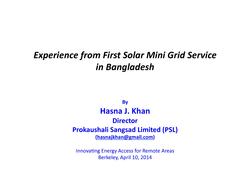Click here to register!
Experience from First Solar Mini Grid Service in Bangladesh
Experience from First Solar Mini Grid Service in Bangladesh
Presenter: Hasna. J. Khan, (Prokaushali Sangsad Limited, Bangladesh)
Rapporteur: Avantika Jalan
Overview
| A 100 kW solar minigrid service in the remote off-grid rural market of Sandwip island of Bangladesh has shown technical and commercial viability for the service provider. Financial planning of solar minigrid requires an optimum blend of consumer categories to ensure maximum socio-economic return on investment. Demand and supply side energy management is an important component of stable power supply from the solar minigrid. Policy-wise, subsidized financing with attractive incentives for the private service providers is essential at this early stage of solar minigrid deployment[1]. |
Main Topics Discussed
- • Fist solar mini grid in Bangldesh
- • Institutional design, what rural people need
- • Market area
- • Solar grids can replace diesel generators- 8000 markets out there
- • Road network all over country but small portion of rural network electrified.
- • Solar mini grids in Sandwip Island
- • Not accessible during some months due to Hymalaya water
- • Many natural disasters
- • 100kw solar mini grid
- • Started with survey of potential consumers: what will it be? Demand of people could be et with solar. Already using diesel. Thus did load assessment. No solar grid at that time. Wanted energy from Germany
- • ICOL infrastructure development company in Bangladesh
- • Planning how project operate and pay for loans
- • 50% grant for the project. But kw/h was not sufficient to pay for loan
- • Government lines never energized for about 20 years
- • A lot of economic activity but no power
- • Restricted use to laps, fridge, electric appliances
- • Load profile, before 9am rather unused. In the evening the largest demand
- • 60kw of solar connected at the top. About 40kw tied directly to batteries and 40kw of diesel as a backup (for overcast)
- • Would not add charger in the bottom of the pyramid again
- • Infrastructure: carried materials by boat. Cost increases because of weather complications
- • Batteries placed before walls put up
- • 11kw each grid inverter
- • Solar mini grid has a major challenge the operation, meeting the demand of the people
- • Took about 3 years before consumers were connected- had to prove they were reliable
- • Energy consumption- November and December is lower demand
- • Utilities look at the consumers. The large consumers actually consume as much as those as all small consumers
- • 299kw/h is a large connection
- • Hourly yield changes to a peak in the mid day- having grid electricity changes the load pattern
- • For early starting time there have to be subsidies for private companies otherwise they would not enter in the first place
- • Sponsor was a Gov. agency for private sector. They get a loan from like World Bank
- • $723000 US= total cost of project
- • 35 taka- about US$0.40 cost of energy, they charge
- • To generate it costs 25 taka kw/h
- • The costs would be lower now because cost of solar has decreased
- • The solar modules are directly connected to battery and that means extra hardware everywhere which means extra costs
- • Battery lifetime- 7 years
• Solar Panels can replace diesel generators
• Large demand only1% rural Bangladesh is electrified
• Disasters and storms common in the area
• Survey showed demand of the user could be met with solar mini-grid.
• SMA from Germany – inverter manufacturers – they collaborated with them. (being 1st mini grid program for Bangladesh).
• If there is 20% equity from private sector, there will be a 30% funding from the loan.
• Lot of economic activity – but no power. A lot of demand side management they had to do – to make power available to the market. Restricted use to lights, fridge, fans, and few appliances.
• Grid chargers are inefficient – learning from their experience, they wouldn’t redo it if they had to do it today
• Installation is not the challenge, the operation is.
• Income for financers fluctuate with the energy generation fluctuation that is seasonal.
Questions Posed
Investments and Costs
What was the cost of production? (~40 cents, 28 taka) which is almost the same amount as the cost /kwh for the consumers.
If you were to install the project today, would the costs be lower? – Answer was an affirmative yes, since the costs for solar panels over all has come down a lot since their project was installed.
Have the batteries been replaced yet? Not yet, hope is it will last at least for 10 years.
References
- ↑ Experience from First Solar Minigrid Service in Bangladesh. Hasna J. Khan, Asma J. Huque, Kaysar Ahmed Sagor, Tanvir Ahmed, Rashedul Alam, and M. Riazul Hamidi.





















